“I can see Collinwood — but not the Collinwood of today!”
As we careen toward the conclusion of this rattletrap of a television show, I’ve been peering into David Collins’ crystal ball, which now happens to be in my personal possession for reasons that I’ll tell you about later, and I’ve been looking forward into the future of Dark Shadows, to see what happens to this story, once the story is over. This is the War for Dark Shadows, the battle to determine what this story becomes in the decades ahead.
As we all know, the organizing principle of Dark Shadows is Oh my god, what are we going to do next, the agonized heartcry of a team of writers and producers trying desperately to stay ahead of the audience. The only way to do this is to triangulate based on what the viewers are currently responding to, and then steer towards the next surprise.
To demonstrate how difficult this is, today we’re going to look at the Dark Shadows comic book series produced by Dynamite Entertainment from 2011 to 2013.
For people who aren’t aware of Dynamite Entertainment — which is probably most people in America today — it’s a company devoted to publishing mostly dreary comic books based on characters that nobody else wants. They started out in 2005 with an Army of Darkness comic, and then added Red Sonja, a cheesecake sword-and-sorcery spinoff of Conan the Barbarian who first appeared in a Marvel comic and then inexplicably fell into the public domain.
It turns out there are a number of well-known characters in the public domain, so Dynamite has comics based on Dracula, Tarzan, Zorro and John Carter of Mars, as well as licensed properties like The Terminator, RoboCop and The Green Hornet. They also continued some 1980s Jack Kirby comics that you never heard of, like Captain Victory and the Galactic Rangers, and they upped the cheesecake factor with a new Vampirella series.
Basically, the deal is that if IDW doesn’t want the property and Titan Comics doesn’t want the property, then it goes to Dynamite. It’s not exactly a prestige gig.
In 2011 — with a blockbuster Tim Burton x Johnny Depp Dark Shadows film just over the horizon — Dynamite secured the rights to the DS characters, and produced 23 issues with stylish but almost entirely interchangeable covers.
They began with a four-issue story written by Stuart Manning about Angelique returning to menace the Collins family. Then Mark Raicht took over scripting for the rest of the series, with a serialized soap opera-ish bloodsoaked splatter teen romance time travel story from issues #6 to 23.
Dynamite also produced two miniseries, the first of which was the five-issue Dark Shadows/Vampirella crossover which nobody was waiting for, and a reinterpretation of the 1795 storyline in a six-issue Dark Shadows: Year One miniseries.
I’m not sure how much of this I will ever have the stomach to cover, but I’m going to start with the first four issues, and we’ll see whether this first story manages to deliver the surprise that a Dark Shadows story needs in order to survive. Spoiler: it does not manage this.
As I said, these issues were written by Stuart Manning, who was an old hand on Dark Shadows spinoff media by this point. Manning began in DS fandom in 1996 with the brilliant print zine Dark Shadows Journal, which became a website, Collinwood.net, in 2001, and then had a spinoff blog, Dark Shadows News Page, starting in 2008.
Manning was the first producer on the Big Finish audio dramas from 2006 until 2010, and he wrote the first full-cast play, The House of Despair, and co-wrote the second, Kingdom of the Dead. He also wrote the Maggie Evans stories Clothes of Sand and The Ghost Watcher in 2008, as well as Jonathan Frid’s only entry in the Big Finish series, The Night Whispers, in 2010.
Now, that means that there are people reading this blog who probably know Stuart Manning, and I might want to moderate the tone a bit, in case somebody shows it to him. Unfortunately, I am very rarely able to accomplish that, and that is why I have no friends except for you.
Manning’s approach here is to go the “trad” route, beginning a post-cancellation 1971 storyline with opening narration by Dr. Julia Hoffman.
Julia’s got a pretty big part in Dynamite’s Dark Shadows, which is helpful, because so many Dark Shadows spinoffs sideline the single best character in fiction, either because they don’t appreciate the character (The Salem Branch), never knew that she existed (the comic strip), or started after Grayson Hall was dead (Big Finish, until Bloodline). I can’t say that she really shines in this story, because, as we’ll see, the hero parts are reserved for Barnabas and Quentin, with Julia either being possessed or fretting about injecting Barnabas with stuff.
We’ve also got the core Collinses on hand, ready to get possessed by whatever foul fiend is lurking just on the other side of the veil.
Art-wise in these issues, the character drawing is fine, although sometimes you have to meet the artist halfway. You get a lot of suggestion and shadows, and if you’re committed to the idea that the drawings should look like the actors, then you can get there without too much effort on your part.
The artist for these first four issues is Aaron Campbell, who worked on a number of Dynamite public-domain projects like The Green Hornet, Sherlock Holmes and The Shadow.
In 2019, he moved to DC Comics to draw John Constantine: Hellblazer, which looks a lot better than his Dark Shadows work, because a) he’s improved and b) the editors at DC actually care what the art looks like.
In this series, Campbell’s main concern is fidelity to the sets; in the trade paperback, there are seven extra “behind-the-scenes” pages by Campbell, and five of them are about the backgrounds. He says that he created a 3D model of the Collinwood and Old House sets so that he could get authentic camera angles, and you have to admit he nailed this shot out the drawing room doors, with the staircase and the newel post in the background. Say what you like about the art in this comic, the man knows his newel posts.
We find the family at a typically anxious, lonely moment in their lives. They’ve all experienced great loss recently, especially the cancellation of their television show, which would render anyone fairly moody.
And then there’s Barnabas, who we meet following a rather fabulous shot of the Old House. The sun is setting, so Barnabas is probably up and around, doing something interesting like —
Ah, okay. Got it. It’s one of these.
The story takes us straight into a coffin dream sequence, with Barnabas receiving a vision from the beyond, which tells him that Angelique is about to arrive on track 2. This intel is delivered to Barnabas through the medium of a floating witch upshot, and she’s got her Night of Dark Shadows beckoning robes on.
You’re going to get these floating Angelique pteranodon shots when you reboot Dark Shadows, because your main villain is a pretty young woman, and the quickest way to let everyone know that she’s dangerous is to suspend her from the ceiling wearing a flowing white gown. You don’t see a lot of these in the course of daily life, but Dark Shadows reboots are full of them.
So it’s here, on page 7, when you start to really understand the comic’s approach, and exactly how disappointing it’s about to be. In this vision, Barnabas and Angelique go over their relationship status, so that new readers can understand what this is all about. It sounds like this:
Angelique: Eternity, Barnabas! That is how long I shall make you suffer!
Barnabas: No, Angelique! Why must you torment me? I was freed from my curse!
Angelique: Your love might have changed me, but that love soon fades.
Barnabas: No! I can’t do this again! I can’t live as a vampire!
Angelique: We are bound across time, Barnabas! Wherever you go, I shall follow and make you pay for your betrayal! Hahahahahahahahaha! Until we meet again, Barnabas!
Barnabas: Angelique! Come back!
So, where have we heard Angelique and Barnabas dialogue like that?
Oh, right, in literally every Barnabas/Angelique scene ever written in any medium.
I mean, you could make a bingo card with:
- suffer
- torment
- curse
- time
- love
- eternity
- betrayal
- I will make you pay
- Ha ha ha ha ha!
on it, and you’d do pretty well in any given Barnabas/Angelique scene from 1969 to 1991 to 2012. This comic book manages to check every single box on that list in four panels.
Barnabas even says “Come back!” at the end of that sequence, which is one of my favorite television clichés, because nobody ever comes back. Except Angelique, I suppose, who never does anything else.
But there is some legit soap opera fam dram in this comic, and I have to give props for that. The Parker novels and the Gold Key comics basically treated the four family members as — well, as props, actually, just standing in the background while the monsters get the storylines. But this story has a real storyline for Carolyn, who’s grieving for her dead husband but may be starting to move on with her life. It’s not a very interesting storyline, and it ends badly, but Manning recognizes that characters need motivations and plot points, and I appreciate the effort.
And hey, there’s that newel post again, thanks to Aaron Campbell.
It’s in the next panel, too. In fact, we see that newel post six times in this issue; it’s possible that Campbell’s 3D models revolve mostly around the newel posts. You know, I’m not sure I’ve ever written the phrase “newel post” before in my life, but today I’ve done it six times, and I’m not sure I’ll ever be able to stop.
But enough about my problems. We spend the following pages skipping back and forth between Julia and Barnabas being frustrated at the Old House, and Carolyn going to the Blue Whale, and that fills up a lot of the first issue until we get to the cliffhanger page. Like the show itself, the story is basically built around the issue-ending cliffhangers, and the rest of it is mostly shadows and people looking anxious.
One thing that’s new in these comics is that Barnabas is crazy thirsty, like, all of the time. On the show, you’d hardly notice that he drinks blood most of the time; for Barnabas, biting is more often about asserting dominance over people than it is about sustenance. But in this comic, every vampire has to eat pretty much every night, and if Barnabas doesn’t want to deal with the repercussions of killing seven townspeople per week, then he needs to go and drain a deer.
Seriously, that’s a thing in this comic. There’s a scene in issue #6 where Barnabas comes back to the Old House with deer all over his face, and in issue #10 there’s a full splash page of another vampire killing a deer. I guess the cows were busy.
See, the problem is that Dynamite thinks that Dark Shadows is horror, which means a significant body count and regular trips to the torture dungeons. As we know, Dark Shadows isn’t really horror at all, it’s psychedelic comedy-mystery soap opera with supernatural and science-fiction elements, which is a whole genre that they invented accidentally.
On ABC-TV’s Dark Shadows, people got locked up and menaced a lot, but you never saw, for example, a pack of murdered children slaughtering their own parents in a damp cave, like we do in Dynamite issue #9, because that’s gross and depressing, and it would make the housewives in the audience less interested in buying L’eggs pantyhose and Ken-L-Ration dog food. The housewives would take one look at that murderous horde of rampaging child zombies, and they’d say, how am I ever going to get those stains out? And just look what you’ve done to your dress slacks! The show wouldn’t last a week.
This comic doesn’t really take the housewives into account, and I think we’re worse off for it. I know that we don’t really have housewives anymore, at least not the way that we used to, and even if we did, they wouldn’t be buying Dynamite comic books, but when you get right down to it, why do we have anybody buying Dynamite comic books? I mean, is there really a reading public for an Aliens/Vampirella crossover comic, and if so, why?
But look what they’re doing here, they’re giving Carolyn a new love interest, bartender Jack Harkins. I’d call it a meet-cute, but he works here and Liz says that Carolyn goes out drinking a lot, so they must have already met, and actually it’s surprising that they’ve never flirted with each other before.
Jack is an attractive young man, according to about 58 percent of the panels that he’s in, and he has some nice banter with Carolyn, if you classify lines like “Miss Stoddard, we have to stop meeting like this” as jokes.
So now we’re getting set up for the first-issue cliffhanger, which — like most Dark Shadows cliffhangers — is overly complicated, and ends up not making sense in hindsight. Let me try to walk you through it.
First, there’s a statue, I guess? And it’s of Angelique. It seems like it’s somewhere on the Old House grounds, but nobody’s noticed it before, which is weird because it’s all overgrown with ivy and it’s obviously been there for a long time, and I know that people at the great estate have a lot on their minds but you’d think somebody would have spotted this before now.
Julia’s the lucky person who runs across the statue, and as she gets close, it turns out that it has electrical powers that light up Julia’s eyes and put her under the possession of that she-witch Angelique.
There’s a nice electric-blue digital coloring effect that they use for the possession eyes which is quite effective. There are actually a lot of spot effects throughout the comic that couldn’t be done back in the days when people actually colored comic book pages on art boards. I like these effects a lot, and yeah, maybe they’re overused, but what’s Dark Shadows for, if not to give people a reason to overuse a gimmick. Dan Curtis would be eating this up.
There are actually quite a few characters who are currently possessed by Angelique, which we’ll discover as their eyes start to light up, but Julia’s the only one that we see near the statue. I don’t know how everybody else got possessed at long range. I’m not a scientist.
Then it’s time for some pretty girl in peril, with Carolyn parking her car outside Collinwood. As we have learned time and again, in the early stages of a Dark Shadows reboot, the one thing that you don’t want to be is a young woman outside at night. You’d think Carolyn would have learned this by now. I don’t want to blame the victim, obviously, but if you’re a pretty girl and it’s right before the second commercial break then you need to get your ass indoors.
Then there’s a plot thread from nowhere that also turns out to be retrospectively nonsensical, with Roger and Elizabeth walking out of the drawing room and seeing the words SHE APPROACHES written above the front door in what is obviously blood. Stay tuned for them to jump to the conclusion that young David has suddenly gone full-on Manson family insane.
And this is the final splash panel: Julia coming across Barnabas, who’s just come across Carolyn, who’s on the ground with bite marks in her neck, and that’s your first issue all taken care of.
Now, the retrospective problem with this cliffhanger construction is that we’re going to learn at the end of issue #2 that Julia is actually the one who inflicted these wounds on Carolyn, which means that after the assault, Julia must have dropped Carolyn on the ground and then walked around in a circle, just to pretend to be shocked that Barnabas apparently attacked somebody that she actually attacked herself.
On the other hand, when Krypton exploded, Superman was a baby and Supergirl was a teenager, but by the time Supergirl arrived on Earth, Superman was a full-grown adult and she was still a teenager, so fuck comics, I guess.
Okay, issue #2, where Roger tells his teenage son, “David Collins, get down here this instant!” because somebody’s written SHE APPROACHES in blood over the front door, and Roger thinks that inscribing a supernatural threat on the wall in human body fluids is a common prank that one plays as a teenager, especially at home, where there are no other suspects except you.
David’s first response is “What is it, father?” and his second is “I didn’t do it, father!” so you shouldn’t expect much in the way of character development from David Collins for the foreseeable.
Also, again retrospectively, by the end of this issue we’re going to learn that David, Liz and Roger are all possessed by Angelique and they’ve been obsessively writing the phrase SHE APPROACHES for I don’t know how long, so why everybody is currently surprised to see this I don’t really know. There is a lot that I don’t understand about Angelique’s current plan.
So Barnabas arrives, carrying the injured Carolyn into the foyer and then dumping her on the floor, as per standard protocol. Everybody talks it over for a couple panels, and then Roger picks up the patient and carries her all the way up the stairs, while the doctor stays in the foyer and has a discussion about something else. Also, there’s another nice shot of the newel post, if you want one.
And then everybody looks up, and it turns out that the inscrutable hellmouth poltergeist vandalism is getting even more aggressive and frightening, which we see from a camera angle that still manages to include that goddamned newel post.
The difficult thing about this moment in my life is that I’m probably never going to be able to look at the Collinwood foyer the same way again without obsessing over the newel post, although technically that’s only going to be a problem for another twenty-nine episodes.
Anyway, Quentin decides that the only way to figure out this is to hold a seance in the drawing room, and I guess this is a good a time as any to bring up Return to Collinwood.
You may recall that I wrote about Return to Collinwood in the post for episode 1190; it was the first Dark Shadows audio drama, performed live at the 2003 Dark Shadows Festival by a full cast of whoever was still alive and interested in appearing at Dark Shadows Festivals.
Return to Collinwood takes place more or less in the 1990s, after Elizabeth and Roger have died. Carolyn is the mistress of Collinwood, and in the first half of the play, the big plot point is that the spirit of Angelique has been hypnotically communicating with Carolyn, influencing her to bring about Angelique’s return to life. There’s talk about “the mistress” and “the lady”, and Carolyn organizes a seance that’s supposed to be about reaching Elizabeth, but is actually intended to summon Angelique.
During the seance scene, the other participants experience some hypnotic suggestion as well, chanting “Come to us!” at Carolyn’s command, and then Angelique breaks through to our world once more, and they end up running through the usual checklist: eternity, betrayal, time, ha ha ha ha ha, and so on.
In this comic, they say “she approaches” instead of “come to us,” but besides that, it’s pretty much the same story. Angelique is reaching out from the spirit world, supernaturally influencing Collins family members to bring her back to life through a seance.
So where else have we seen this plot point of Angelique tricking/possessing people into resurrecting her? Well, there’s 1970 Parallel Time, as well as Night of Dark Shadows, the 2004 WB pilot and Manning’s own 2006 audio, The House of Despair. People just can’t seem to kick the habit of calling Angelique into existence.
I mean, I get why a writer would go back to this particular well, especially in a story set in post-1971. This comic already has three of the four major kaiju — Barnabas, Julia and Quentin — and it makes sense that Manning wants to get a complete set. Still, he’s repeating a plot point that’s already been pretty thoroughly explored.
I mean, as Morticia Addams once said, “You have married Fester. You have destroyed his spirit. You have taken him from us. All that I could forgive. But, Debbie… pastels?” That’s how I’m feeling right now.
Anyway, post-seance, Carolyn gets her own set of glowing electric hypnotised eyes, and the next day, Quentin sees her leaving the house and decides to follow her. It’s not clear if he can see the eyes effect or it’s just for the reader’s benefit, but if he can’t see the glow, then I don’t know why he’s trailing somebody who is apparently just going outside.
Carolyn leads Quentin to the Angelique statue, and then kind of slips out of sight somehow. Quentin approaches the statue and touches it, which brings on another electric storm and a fresh threat about using his immortality to bring her back to life, as per.
So then we get another beckoning upshot, with Angelique throwing random shade at Quentin about his hidden sins, which I already know about and they’re not particularly germane.
Quentin gets mad, naturally, and when she calls him, “Thief, drunkard, murderer!” he replies, “You forgot one!.. Werewolf!”
And then he just goes ahead and turns into a werewolf on purpose, which is a thing that Quentin does in this comic book series; he can just turn it on and off whenever he feels like it. Most of the time, he doesn’t even go all the way to full wolf; there’s a scene in issue #4 where he’s got a wolf head and wolf hands, but he’s still able to talk, so that he can tell Barnabas that he’s being an asshole.
I can understand why the creators of a Dark Shadows comic would want to do this. Quentin is best known for being a werewolf, even if his curse was only active for a few months in 1969, and having a character who can turn into a werewolf is a huge plus for a comic book, because literally any story ever told could be significantly improved by putting a werewolf in it. Imagine if Philippa Featherington turned into a werewolf in the second season of Bridgerton; wouldn’t that open up a whole new range of interesting story options?
But a cured werewolf is of no use at all, as Dark Shadows discovered in the fall of 1970, and waiting around for a full moon before every transformation is an inconvenience that delays story progression. Therefore: Dynamite Quentin has a new set of skills.
Quentin turning into a werewolf seems to surprise Angelique for some reason, so she backs off. Recovering, he decides that he has to go find Barnabas… and then we see Julia, hiding behind a tree with sparkling electric eyes, and grinning, “That’s right, Quentin. Go and fetch him.”
So apparently this was a complex, brilliant plan, which is utterly pointless. As I understand it, Angelique commanded Carolyn to leave the house, so that Quentin would follow her and discover the statue, and then she commanded Julia to hide behind a tree, watching to see that Quentin goes and brings Barnabas here.
On the next page, Carolyn comes out of her trance, and says, “I have the feeling I’ve just done something terrible!” which apparently refers to leading Quentin to the statue, but how is this even a plan?
I mean, yes, it works, obviously it works, ten out of ten for hitting your target objective, but if you wanted Barnabas to come look at the statue, all you have to do is have Julia walk into the Old House and say, Barnabas, I’ve found a mysterious statue in the woods that looks like Angelique! Barnabas, you should come and see it! Oh, Barnabas, be careful! Barnabas! and that’s all there is to it.
You don’t need a whole team of operatives to get a person to come and look at something interesting. What is Angelique’s business case for all of these new hires?
So now it’s time for the nonsensical reveal that I mentioned at the end of issue #1, where Julia pushes Quentin forward so that he falls against the statue’s outstretched fingers, and he gets two little cuts on his hand from the statue’s nails or something.
So Quentin realizes the the two little cuts on his hand look like a vampire’s bite marks, and Barnabas says, “Carolyn… that was you!” and now we’re supposed to believe that Julia knocked Carolyn unconscious on the driveway, dragged her all the way across the lawn and through the woods to the statue, pushed her neck up against the statue’s sharp fingers, and then dragged her to wherever Barnabas eventually found her, just for the sake of pretending that Barnabas bit Carolyn on the neck, which nobody would even notice except for Quentin and Julia herself, and didn’t contribute anything to the actual story, except to give us an exciting splash page at the end of the first issue.
I mean, I am all for lunatic plot contrivances in the service of an exciting splash page cliffhanger, but honestly, there are limits.
And then we get another stupid reveal, which is that all of the Collins family members have been hypnotized this entire time, and they’ve been repeating “she approaches” to themselves in order to contribute to Angelique’s unnecessary plan.
That includes David obsessively writing “she approaches” on a pad of paper, and Liz stitching “she approaches” in her needlepoint, which is so impossibly idiotic that I don’t know how I’m ever going to recover from it.
Because that means that yet another element of the first issue cliffhanger was false — Liz, Roger and David finding “SHE APPROACHES” written in blood in the foyer, which they pretended was a mystery even though they’ve all been part of the “she approaches” club from the beginning. So everything that happened in the first issue was basically stagecraft for, I guess, Quentin’s benefit? I don’t know.
But the show rattles on somehow, and smearing a bit of Quentin’s immortal blood on the statue causes the stone to splinter apart, and then there’s Angelique on the pedestal surrounded by a shower of electric blue sparks, proclaiming, “I have returned! ANGELIQUE LIVES!”
So at least we’ve completed the “she approaches” phase of our lives, which is comforting, and that’s the end of issue #2.
Okay, so the big twist of issue #3 is that it’s still Dark Shadows, and it’s exactly what you would expect to happen next.
At one point in this issue, Quentin and Barnabas walk into the exquisitely rendered Collinwood drawing room, to find Roger, Elizabeth and David striking an unmoving pose, with electric blue eye beams as accents.
Barnabas says, “Elizabeth, can you hear me?” and Quentin says, “It’s like they’re frozen,” and if there’s a better metaphor for what’s happening in this comic book series then I don’t need to hear about it.
So Angelique steps down off of the pedestal, returning to Collinwood for the two dozenth time, ta-dah! and she has more or less the exact conversation that you would expect her to have with a bitter Barnabas and Quentin.
She points out that Barnabas used to love her, and he says that was when you were human, and she talks about being cold and dead, and now she has the warmth of life flowing through her veins, and it is just impossibly predictable and grim.
Then she makes her usual vague threats and flies away into the sky, which I guess is a thing that she’s doing now. And Quentin actually says “Angelique, come back!” which, again, never works.
Naturally, Angelique heads straight for the Blue Whale, where she flirts with Carolyn’s new bartender boyfriend. Julia shows up and tells her whatever she’s doing right now won’t make Barnabas love her, and Angelique says that she knows and she doesn’t care.
“I have no choice,” says the villain of the story, unwilling to offer any internal motivation for what’s happening. “He and I are bound to one another eternally.” Yeah, you can say that again.
So that’s what happens, in these endless rematches, whether it’s Gold Key or Dynamite or HarperCollins. Angelique and Barnabas will always be pointlessly circling each other, eternally locked in battle because they can’t think of anything else to do.
It’s issue #3 and we still haven’t killed any women, so Barnabas is struck with another craving, and he claims that he can’t fight Angelique unless he gets some nutrition of the female variety. Quentin accompanies him down to the docks for take-out, and tries to put some guardrails on the serial rapist.
“You only take the bare minimum, understand?” says Quentin, the heroic protector, as he prepares to referee the upcoming sexual assault. As everyone knows, it’s okay to grab pretty young women who are out after dark, as long as you stick to the minimum required to satisfy your particular craving.
The plan doesn’t really work out, go figure, because Barnabas starts to enjoy himself and decides that as long as he’s assaulting someone, then he might as well murder them too. Quentin takes a more moderate position, which just goes to show that America isn’t as polarized as people say.
Oh, and Angelique sucks all the warmth out of Carolyn’s boyfriend and leaves him cold and dead on the ground, and that is the unsurprising twist at the end of issue #3.
This brings us to issue #4, and the depressing conclusion.
The issue starts with some solid action, as Quentin partially turns into a werewolf, rips Barnabas away from the victim, and scolds him for doing the exact thing that they just agreed that he would do.
This turns into the one worthwhile sequence in the entire story, a Wolfman v. Batman: Dawn of Justice fight scene that lasts four pages and is actually really fun. It offers cool visuals, it’s both scary and silly, and we’ve never seen anything like it in any other version of Dark Shadows.
This proves that it is possible to make a Dark Shadows comic that’s worth reading, as long as you stop trying to be so grim and violent, and focus on the fun.
Okay, back to the grind. Angelique shows up, and she’s still hungry even though she just ate Carolyn’s boyfriend eight pages ago. In fact, Angelique is already visibly turning into stone, which means she needs to burn through the humans like a five-pack-a-day smoker. This would be a real problem if the story was going to last for much longer, because you can’t keep up that kind of pace. As a villain, Stone Angelique is not scaleable.
Angelique breaks up the monster bro fight, and then she settles the question of who gets to kill the young woman, because obviously that’s a problem that needs to get taken care of. This involves what I believe is the first example of girl-girl kissing in Dark Shadows — Big Finish will get there, but I don’t think they were quite there in 2011 yet — but instead of romantic and empowering, it’s just another version of hypnotic date rape of an undeveloped female character, and it offers the audience a compelling reason to just stop caring about what happens in this comic book.
Since we’re here, I would like to take this moment to discuss how to write Angelique correctly. This comic exemplifies the boring version of Angelique, who concentrates on vengeance, and nothing else. Even the Angelique from Return to Collinwood had a motivation for coming back from the dead; she wanted to hook up with Quentin and take over the Collinwood estate. This Dynamite version of Angelique doesn’t want anything in particular, she’s just killing people and playing pranks. She’s not really a character as much as an overcaffeinated demonic imp, who plays stupid games and wins stupid prizes.
To write Angelique correctly, you need to focus on the two versions of the character that are the most creatively satisfying.
The most successful version, as we all know, is the Angelique who appears in the Gold Key comics issue #1, “The Vampire’s Prey“, where she suddenly appears in the middle of a page and says, “Well, well, Barnabas! How are you, dear Barnabas?” and then she hides inside a sunken treasure chest so that she can scare the daylights out of a nearly-naked college student while he’s scuba diving.
The other successful version of Angelique is the one that blackmails major characters into either marrying her, getting engaged to her, or pretending that they’re already married, as seen in 1795, 1968, 1897, 1840, and, now that I’m thinking about it, Return to Collinwood.
This is the thing that people forget about Angelique: she is a scheming soap vixen, like Becky Sharp from Vanity Fair, Erica Kane from All My Children, Abby Cunningham from Knots Landing, and Amanda Woodward from Melrose Place.
A soap vixen is a specific subtype of the mythopoetic trickster figure, and she creates story-productive mischief, primarily but not exclusively in the romantic sphere. The vixen is always a bit of an underdog — not old enough, not rich enough, usually the second most beautiful girl in the room — and she gets ahead by using her beauty, her intelligence and her guile to manipulate the people around her, and rise above her station. Angelique is the ladies’ maid who schemes against her mistress to become a rich Collins; Amanda is the ruthless co-worker who steals the good girl’s boyfriend and takes over the advertising agency.
Soap vixens are antagonists, wreaking emotional and financial havoc, and screwing up everybody else’s plans. But — and this is very important — they’re not “villains”, in the way that Dynamite is using Angelique here.
If you take the soap vixen and turn her into a remorseless killing machine, then she’s just a threat that needs to be managed, and nothing more. The problem of “vixen Angelique” leads to interesting, character-based story progression. The problem of “chainsaw Angelique” leads to boring dialogue, messy death and the need to remove her from the storyline.
Eventually, this devolves into the ending of a stupid action movie, where the strong dudes save the helpless women from physical danger, including this imbecilic sequence of Quentin as a talking werewolf grabbing a plummeting Carolyn by the arm and somehow not breaking her neck, then carrying her curled up in his arms like a baby.
And then the screaming bitch-shrew Angelique pays the price, falling into little pieces of statuary for no real reason, and ding-dong, the witch is dead.
So we have learned that having a full-blown Dark Shadows fan write your Dark Shadows spinoff story does not necessarily lead to interesting character progression for anybody, because it’s easy to get stuck just writing the same thing over and over again, like Liz and her SHE APPROACHES needlepoint. This might be a good time to learn how to stitch something new.
Tomorrow: The Next to Last.
Note for Dr. Julian Hoffman:
The clock in the credits says 12:49.
This is significant.
More later.
Dark Shadows bloopers to watch out for:
The opening narration says, “For many generations, the Collin family has lived under a curse.”
Carrie asks Quentin what the name was that Melanie said, and it takes him a little too long to come up with “James Forsythe”.
A couple minutes later, Quentin trips on the name: “There’s never been a man by the name of Geors— James Forsyte who’s ever lived at Collinwood.”
While talking to Kendrick, Quentin trips on: “But as you can see, I made a miraculous re-recovery.” Then he forgets his line completely, and has to take a long look at the teleprompter.
Kendrick tells Quentin, “I see you’re all as hospitalable as she is.”
Tomorrow: The Next to Last.
— Danny Horn

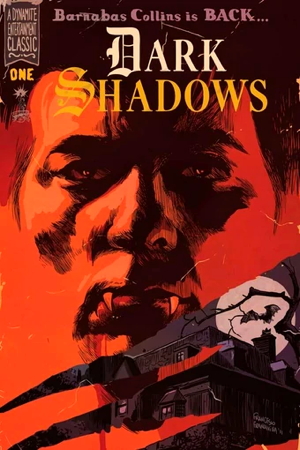
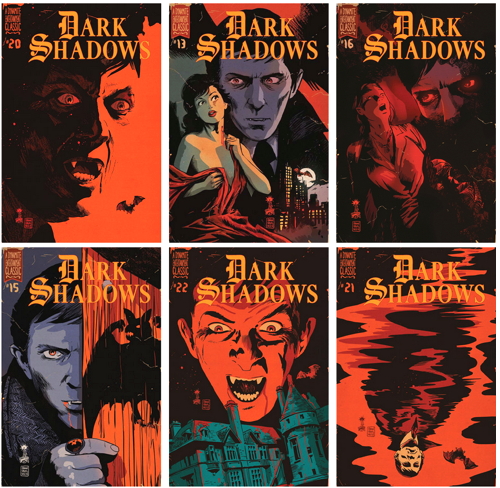




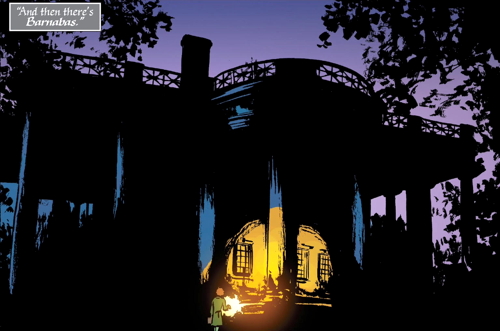

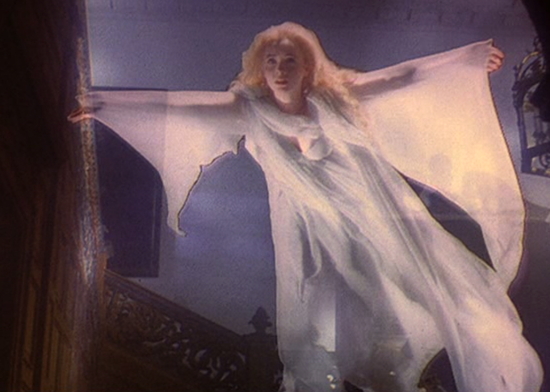






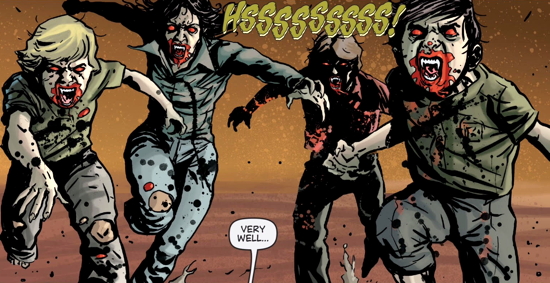




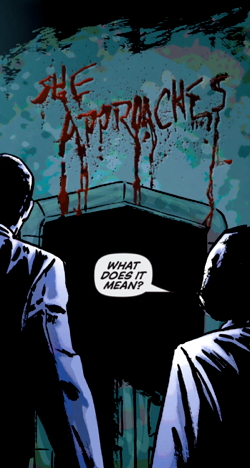
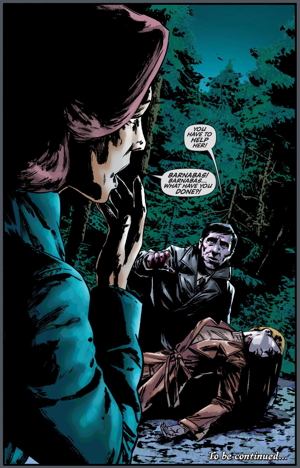

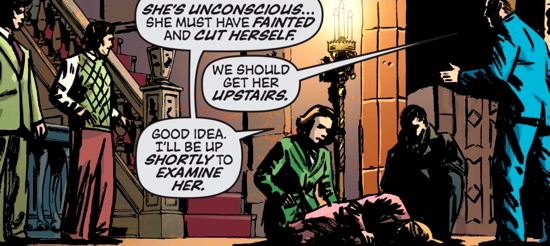
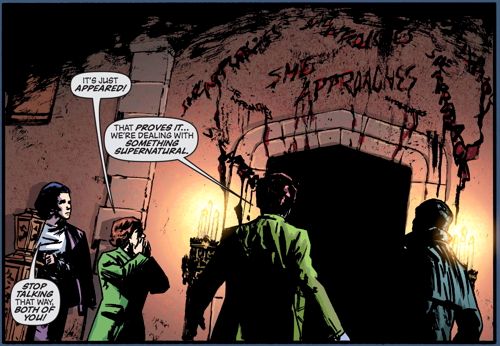
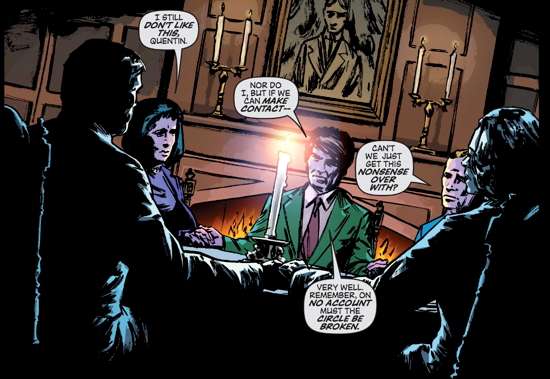

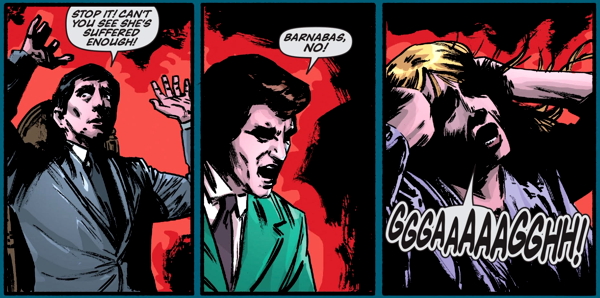


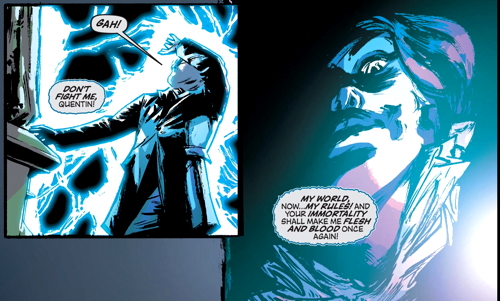
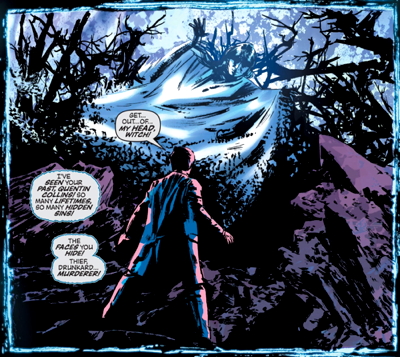


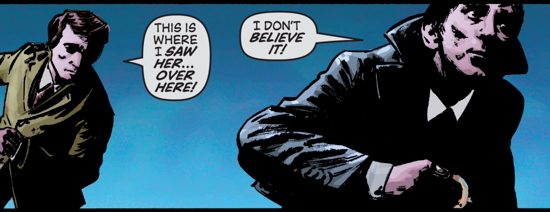
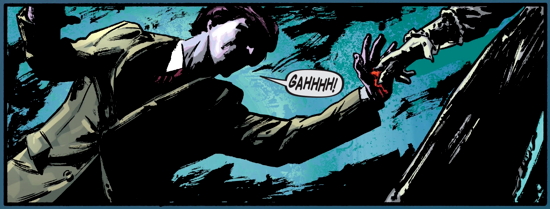
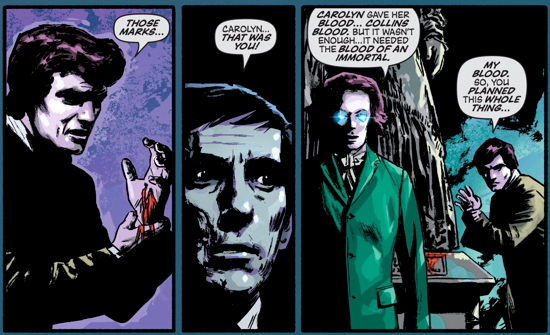



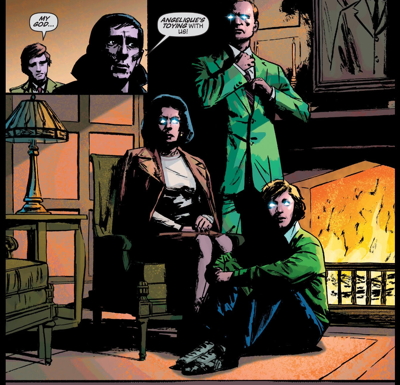


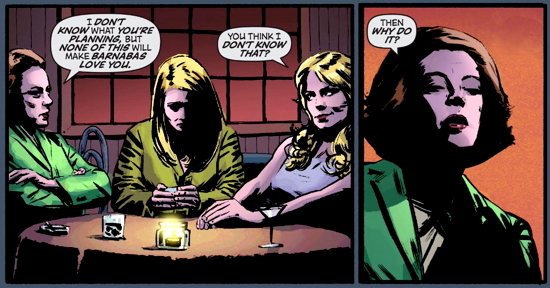






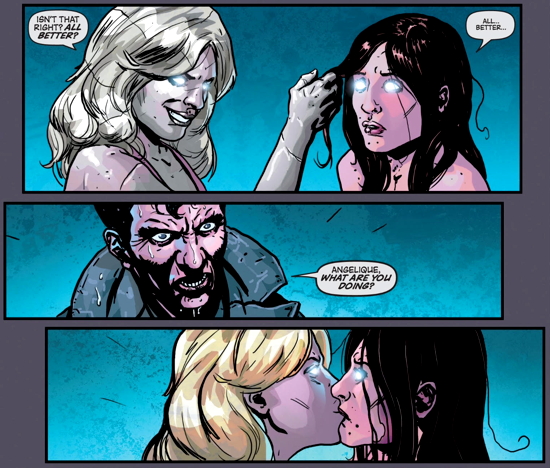
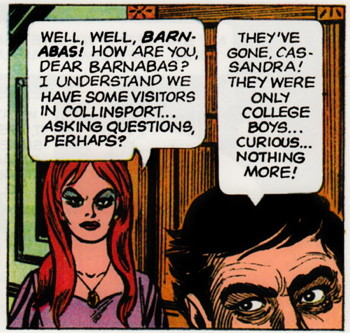

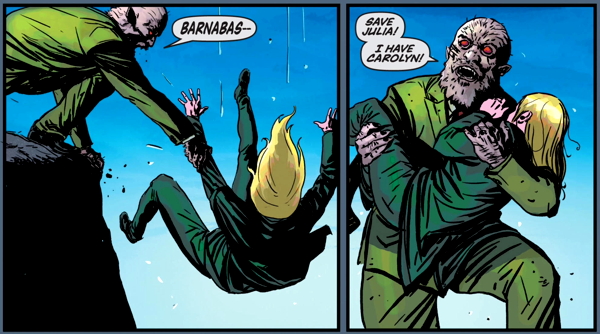

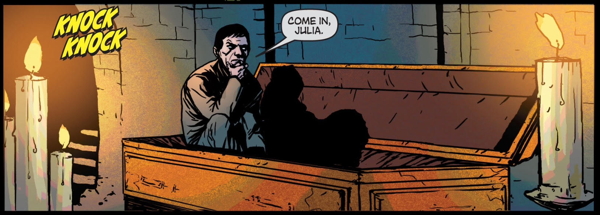

I remember Dynamite. I read it, when there was a Sonja crossover with one of my favorites from the 70s, Claw the Unconquered. Wasn’t as interesting as the original Claw series, but the nerd in me still got excited over it.
Oh, I so wanted to like these. Angelique as a weird comic book vengeance villain doesn’t work so much for me.
I actually enjoyed YEAR ONE (which was a stupid title, but it’s a comic book thing, I guess; see BATMAN YEAR ONE for the original, offendingl culprit) … the art was fabulous (CHECK OUT VILANOVA’S DELIGHTFUL DEPICTION OF NATHAN FORBES … run, don’t walk), the story was more or less what you’d expect (with dialogue that was occasionally ornamental and frequently downright irritating) … but an interesting iteration of the oft-told 1795 storyline. I’m interested to know what you think!
With all due respect, Danny, I don’t know why you spend so much time on the DS knock-offs (Ross, comics, audio, Parkerverse) while still being uninterested in episodes 1-209 which are, after all, the “real thing” and more like episode 210-1245 than any of the ersatz DS material.
The short answer is that I don’t want to. The long answer is that it would bring about the Great Unwinding, and the destruction of all joy and surprise in this timeline.
“a plot thread from nowhere that also turns out to be retrospectively nonsensical”… “unnecessary plan”… “it’s not clear”… “stylish but almost entirely interchangeable”… “not a very interesting storyline, and it ends badly”… “it’s pretty much the same story”… “so impossibly idiotic that I don’t know how I’m ever going to recover from it”… “it’s exactly what you would expect to happen next”… “she has more or less the exact conversation that you would expect her to have”… “offers the audience a compelling reason to just stop caring what happens”
I will now buy these comic books. I am a fan of DARK SHADOWS, and these excerpts describe the show so well that anything else they describe must be a worthy successor to it.
Stuart Manning is the kindest, warmest, bravest, most wonderful human being I’ve ever known in my life.
I think I might own a few of these! I was confused by their connection – the stories looked so familiar that I assumed they were graphic novels of Blish versions of the show.
I might pull them out of the library and give them a read, if only to laugh along with your commentary once more.
“Fixed the newel post!” – Clark Griswold
Had Angelique been spending time with the Leviathans, those pop-up stone monument builders?
If I had read this first, I might not have bothered to listen to Mr. Manning’s Big Finish works. I’m glad I found Big Finish first.
The background is nice but the people! Can anyone make out what is on the paper Roger’s holding?
Oh, Manning’s Big Finish work is very good; I didn’t mean for this to be a slam on his entire body of work. I’m just looking at the comic book story here.
I loved this post and am enjoying trying to follow the clues for the Great Unwinding.
Architectural fidelity aside, the art looks pretty awful. The artist does OK when he’s copying (or tracing) a photo reference but otherwise the faces are just indistinct blobs. Poor Carolyn looks like she’s approaching retirement age in some panels.
I’ve never read any Dark Shadows comics. I did read Superman-DC comics for a long time though. Supergirl wasn’t born on Krypton proper. When Krypton exploded, a big chunk containing Argo City with a bubble of air was flung into space. The ground started turning into Kryptonite, however there were enough rolls of lead shielding to cover the ground. Time passed, and Kara Zor-El was born to Zor-El and Alura. More time passed and Kara grew to be a teenager. Unfortunately, a meteor shower then hit Argo City—uncovering the kryptonite. This time there weren’t anymore rolls of lead in storage. Zor-El happened to have an experimental rocket (as any true son of the house of El would have to have). He had Kara enter it and shot her towards Earth. All the inhabitants of Argo City died, while Kara arrived safely on Earth, where she was united with her cousin Kal-El—Superman.
Oh Danny, I LOVE your line, “As we know, Dark Shadows isn’t really horror at all, it’s psychedelic comedy-mystery soap opera with supernatural and science-fiction elements, which is a whole genre that they invented accidentally.” I think I’ll memorize it, so I can de4scribe DS to the younger ladies at church or wherever who ask me about the DS t-shirt I’m wearing. It explains the genre perfectly (are there even enough other shows to call it a genre?).